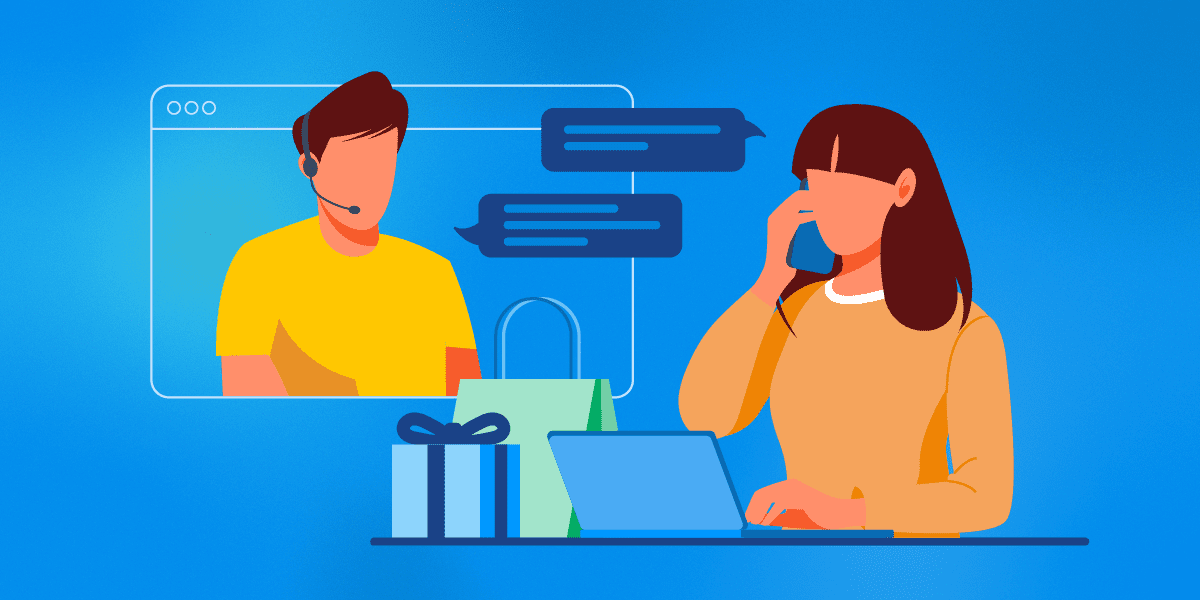5 Tips to Maximize Your Retail Customer Service Amid Peak Shopping Seasons

It’s that time again when the advertising for Black Friday, Cyber Monday and holiday ads flood the airwaves, televisions, email as well as our mailboxes. It’s the season of giving, and therefore– massive shopping spending despite inflation.
Regardless of the time of year, retailers and eCommerce businesses have to plan for numerous shopping seasons. Whether it’s back-to-school, Valentine’s day, Christmas or any other holiday, there’s a sale involved which means your retail customer service department is responsible for preparing two areas:
- Managing a surge of customer inquiries across a variety of channels.
- Ensuring your communications system has the customer experience (CX) tools that can support all of your channels, so your agents can provide the best quality service while improving their performance.
Below, we’re covering everything you need to know about preparing your communications systems for spikes in seasonal traffic to ensure excellent customer service strategy and enhanced agent performance.
When to Start Preparing for Seasonal Traffic Spikes
Ideally, you want to start preparing for peak season 3-4 months in advance. The first thing to look at is your historical call center data. Leverage your VoIP historical reporting to look at peak call volume and KPIs.
Some things to consider include:
- Did we meet our key performance metrics? If not, how do we improve that this year?
- What were the most common customer questions/complaints?
- How much call traffic did we receive and do we have adequate staff to support increased traffic levels this year?
Then develop a 3-month, 2-month and 1-month game plan.
3 months out from peak you will want to:
- Develop volume projections
- Build a peak business continuity plan
- Review last peak season’s results
- Identify gaps
- Identify headcount and technology requirements
2 months out from peak you will want to:
- Start recruiting adequate staff
- Prepare training
- Put the right communications tools into place to ensure streamlined agent performance and great customer service
- Add on alternative support channels
1 month out from peak you will want to:
- Complete training
- Ensure communications plans are in place
- Test tools to ensure they’re prepared for peak call volumes
- Complete contingency planning
5 Ways to Maximize Your Retail Customer Service Strategy
1. Assess and adapt communications
Increased consumer demand can easily lead to a need for more support. And with growing expectations for brands to be everywhere at once, it’s important you prepare to have agents on every channel.
While some customers still prefer speaking to a live agent, more and more expect real-time communications across multiple channels. In fact, 89% have come to expect online self-service support options, and more than one-third want to reach you on social media. This makes it vitally important for your team to not only have inbound call agents but a multi-channel customer service strategy with agents available on social media, email, live chat and SMS.
Customers also feel more comfortable communicating with brands regionally close to them. They’re 4X more likely to answer a call from a local phone number. If your team is running outbound sales efforts, you can enhance your strategy by appearing to be local with a local presence dialing phone number.
2. Optimize your CRM strategy
Your customer relationship management (CRM) system helps your brand monitor and store customer interactions. But if you want to personalize those interactions and track agent performance, having the necessary tech stack tools can make your customer service team’s CRM strategy easier and influence revenue through:
1. Increased caller personalization
There’s nothing worse than spending time giving your information over an IVR, only to be routed to an agent who has no idea who you are or why you’re calling. Personalization is key to the success of customer service.
You can easily tailor the conversation when you integrate your CRM with a cloud communications solution without toggling between the two systems. Below are some unique features generally associated with UCaaS, CCaaS and CPaaS platforms:
- Screen Pops: These are popups on your agent’s webphone that provide the context of who is next in the queue and why they’re calling.
- Dispositions: A notes tool that summarizes the outcome of a call.
- Ex. Left voicemail, Demo booked, Call rejected
- Click-to-Call: Allows agents to auto-dial any phone number or call button on a webpage through their webphones, initiating a screen pop.
2. Enhance customer experience
Without an optimal IVR system, an influx of calls could anger your customers and completely shatter your agent performance metrics. Here’s how to maintain an excellent customer experience in light of a surge in calls.
Get shoppers to the right agent, at the right time. In retail and eCommerce, you tend to serve a wide net of customers. They come from all over the world and may speak several languages. So when they call, it’s important they get routed to agents who share similarities. You can establish this through:
- Skills-Based Routing: Leverage skill tagging to route customers to agents best suited to solve their questions.
- Tags often used include language, geography, VIP, product expertise, department, etc.
- Intelligent Routing: Call routing system that uses skills-based routing, priority routing and traditional queue-based call routing rules collectively.
Let your shoppers skip waiting on hold. Customers don’t have the patience to be on hold– most only wait about two minutes before hanging up. And if they can’t get through to someone, they probably aren’t going to be very happy with your brand.
Since hold times tend to be longer during peak seasons, queue callback is a great way to help customers bypass the elevator music. With callback options, your customers initiate a virtual hold and an agent will call them back.
Quickly onboard seasonal agents. Seasonal hires help brands hit revenue targets and manage additional customer service requests. With the peak season spikes, onboarding new employees require fast training to get them up and running.
With call coaching and live monitoring, you can supply your team with performance-boosting tactics and tips to ramp up training and learn from real-world experiences. Additionally, you can keep a pulse of the issues your customers are having and optimize communications as needed.
3. Prepare for the unexpected
Inflation…supply chain shortages…power outages– If we’ve learned anything from recent years, it’s that anything can instantly upend your operations. That’s where having a business continuity plan for your call center is so critical.
You never know what may happen outside of your control. A few great ways to prepare your call center for the unexpected during peak season include:
- Implementing a disaster recovery team to ensure accountability should a business disruption take place
- Creating call flows to ensure uninterrupted performance across all communications channels
- Opening up more queues and communications channels in regional offices to redirect affected traffic
- Training citizen developers to utilize low-code no-code communications tools to eliminate IT bottlenecks and keep customer service channel strategy undisrupted
4. Understand consumer behaviors and pain points
Another way to maximize your customer service strategy during peak shopping seasons is to think about your customers' behaviors and pain points. Consider questions like:
- What seasonality habits do they have?
- Will they go to a competing brand after a bad experience?
- How much do they spend?
- What channels are they shopping on? Are we on those channels?
93% of customers are likely to make repeated purchases from companies that have excellent customer service. You can make sure that your service and support teams are providing the best experience possible with data-driven insights and simple integrations.
- Advanced Analytics: Extensive analytics and reporting capabilities allow management to see a holistic and detailed view of how customers are being treated from all touch points. For example, if your customers are abandoning more calls than usual, management can quickly identify the problem with the IVR or set up queue callback to ensure customers are serviced on time.
- Reduced Human Error: With robust integrations, your teams can reduce manual togging between platforms– and in return, this will help reduce manual errors and speed up performance.
5. Step up service benchmarks
With the right communications tools in place, you can give your business a competitive edge that not only streamlines customer support workflows but enhances KPIs, including:
- Increase Average Speed of Answer (ASA): By integrating your communications tool with your CRM, you can automate agent call logging in between calls so they spend less time manually documenting and more time helping customers.
- Decrease Call Abandonment Rate: With queue callback and advanced routing, your customers not only don’t have to wait on hold, but they get to the right agent at the right time ensuring their questions are answered quickly.
- Increase Service Level: Service level can set you apart from the competition. And tools like call scoring can do the same for your service agents. Call scoring allows management to quickly spot high-performing agents (and those who need some additional coaching) with a 5-star rating system directly on your dashboard. Other performance metrics include:
-
- Average talk time
- Total calls
- Average wait time
- Agents available
Preparing for Peak Shopping Seasons Depends on Reliable Communications
Peak shopping seasons generally come with a spike in calls and support tickets. But retailers and eCommerce brands have to prepare early on no matter the holiday, especially with unexpected obstacles that could hinder customer service efforts, such as continuing labor shortages, supply chain issues and logistics constraints.
Maximizing your retail customer service strategy is critical to keep your customers happy and your performance metrics on track. Your customer experience depends on it. And having a solid plan and reliable communications solution can help. That’s where AVOXI comes in. We help retailers and eCommerce brands empower exceptional experiences through elevated interaction and CX tools - all within a single platform.

Optimize Your
Peak Season Call Strategy
You're on the front lines of the holiday calls and ticket spikes. Learn how to optimize your call strategy to personalize the shopper experience, and leverage CX features to crush your retail and eCommerce goals during peak seasons.
